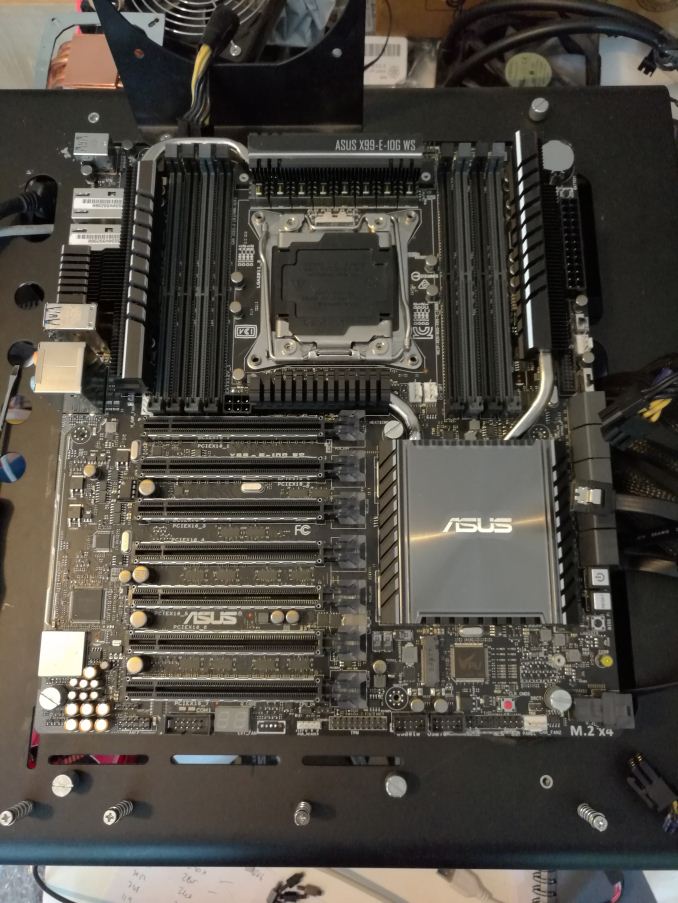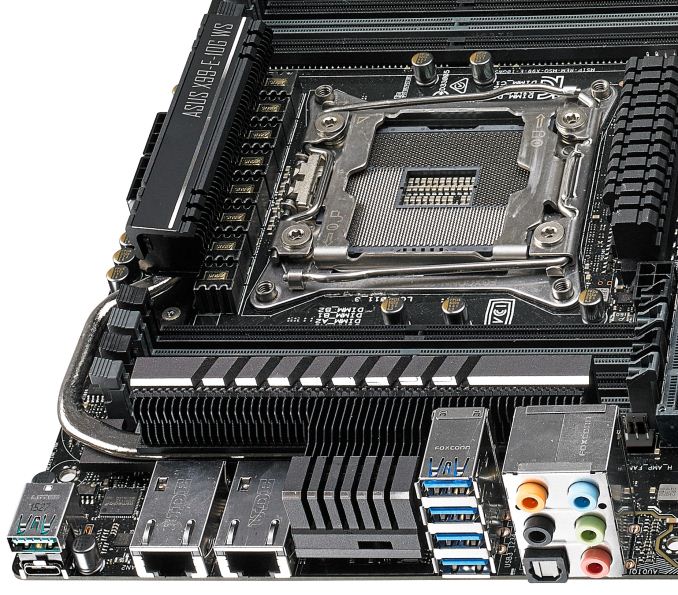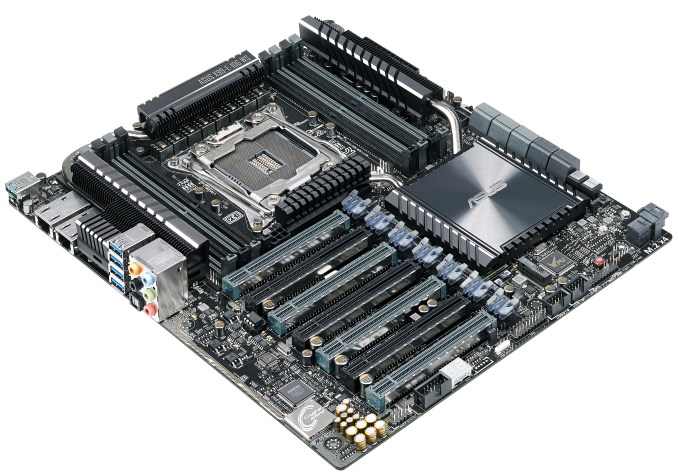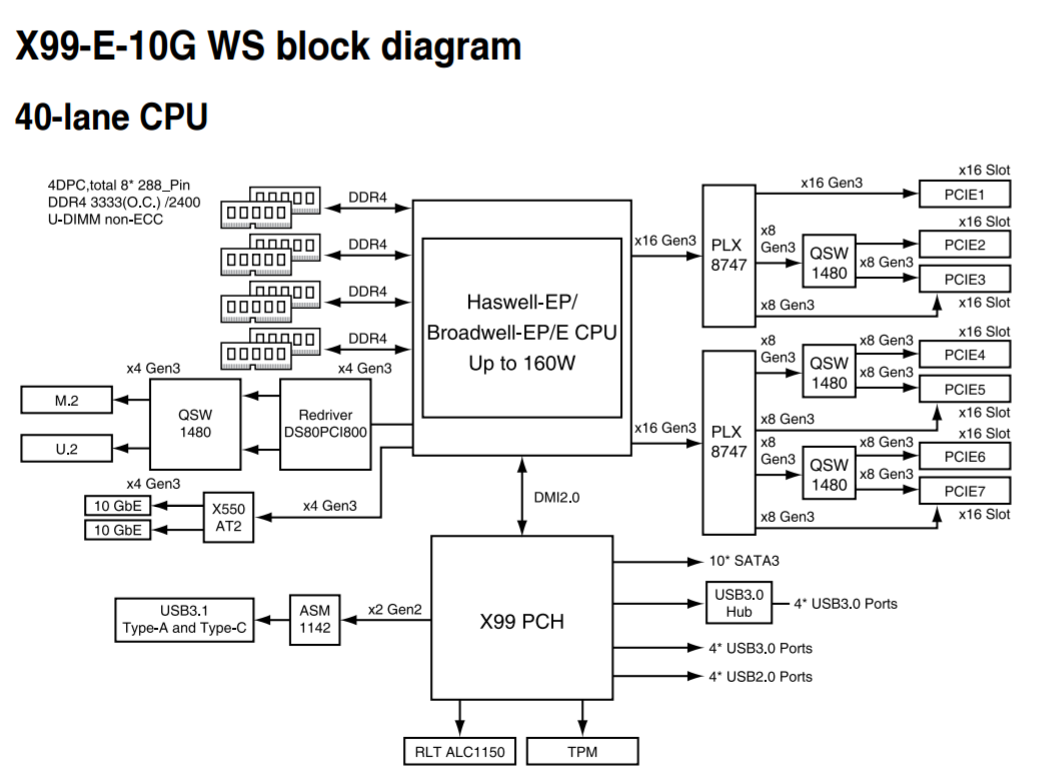ASUS X99-E-10G WS Motherboard Launched: Dual 10GBase-T Ethernet via an Integrated X550-AT2
by Ian Cutress on August 29, 2016 5:20 PM EST- Posted in
- Motherboards
- Asus
- Workstation
- Enterprise
- X99
- 10GBase-T

When we wrote up our list of 10GBase-T capable consumer motherboards back in July, we noted that out of the two main ways to get 10GBase-T on a motherboard, either by and add-in card or via an integrated controller, only one example of the latter existed on the market. For almost two years, that sole motherboard has been the only integrated solution – since then, ASUS launched the Maximus VIII Assembly which comes with a single port add-in card, and we saw a micro-ATX C236 model with a single port from MSI at Computex. We also listed the X99-E-10G WS from ASUS, a new board set to come to the market and we had an early sample. We’re still testing the board, but ASUS is officially announcing it today.
The X99-E-10G WS is built like a brick outhouse, with the focus on premium workstation parts and the latest set of features ASUS could put together while still under the X99 chipset banner, rather than a Xeon chipset. The board is designed for any Broadwell-E CPU, either consumer i7 or Xeon E5 v4, with extensive heatsink arrangements to carry both the Intel X550-AT2 controller (11W), the chipset, the upgraded power delivery and additional controllers.
The main feature is obviously the 10GBase-T ports, which are RJ45 compatible with most home and SMB networks. The X550-T2 controller is a PCIe 3.0 x4 part, which is an upgrade over the older X540-T2 generation that needed PCIe 2.0 x8 (and even at PCIe 3.0, you still needed 8 lanes due to controller limitations). This controller has a list price on Intel’s ARK of $80 for batches of 1000, however it probably adds nearer $100-$150 to the motherboard cost paid for by the end user. Alongside the Ethernet ports are a pair of 10 Gbps USB 3.1 ports (one Type-C), four USB 3.0 ports and the audio.
The board has full support for PCIe graphics, using dual PLX8747s as high-end PCIe switches. This allows support of x16/x16/x16/x16 slots (or x16/x8/x8/x8/x8/x8/x8) while also having enough bandwidth for the X550-T2 controller, a U.2 connector running at PCIe 3.0 x4 as well as an M.2 slot also at PCIe 3.0 x4. The PCIe slots have two additional features, with integrated guard rails in each of the slots to increase rigidity and reduce RMAs, but also the PCIe latches are translucent. When the system is turned on, the main PCIe slot connectors have a LED light that implements a slow breathing effect. Speaking with the motherboard product managers, it turns out that users do not often know which PCIe slots are suitable for maximum bandwidth, and this is designed to help.
The ASUS X99-E-10G WS also comes with 10 SATA 6 Gbps ports, dual USB 3.0 onboard headers, Dr. Power, BIOS Flashback, EZ XMP and an upgraded audio solution. ASUS expects the board to land with an MSRP of $650 with select authorized resellers and distributors soon.
Source: ASUS Edge Up




















40 Comments
View All Comments
chaos215bar2 - Monday, August 29, 2016 - link
If technological progress brought the price of helicopters into the realm of regular consumer cars, then you bet I would buy one. Of course the skies might get a bit crowded with all those helicopters, but the cool thing about wired communications is you don't have to worry about interference from anyone else.Can I assume WiFi protocols capable of exceeding 1 Gb/s also activate your hilarity unit? Can I also assume you don't use Thunderbolt (of any form), USB 3+, or HDMI 2.0+ either, so as to avoid continuous activation of said hilarity unit?
ddriver - Tuesday, August 30, 2016 - link
Well "genius" you finally got it. It is not there because it is too expensive, it is too expensive because it is not mainstream, it is not mainstream because it isn't necessary and because your beloved industry would rather milk it.You couldn't even get why "10gbit internet" is stupid - my hilarity unit's activation has nothing to do with bandwidth, but with the stupidity of those who fail to make a distinction between network connection and internet connection.
ddriver - Tuesday, August 30, 2016 - link
The most laughable thing however is that of all the things you actually need badly and are completely clueless about, yet you whine about the industry not giving you something you practically don't need.Morawka - Tuesday, August 30, 2016 - link
i'm pretty sure most of the consumer sector is gonna need speeds faster than 100 MB per second for 4K media, hell even some high quality Blu Ray rips exceed that bandwidth. These features are for future proofing as well. As more homes get acces to Gigabit fiber/coaxial, the need for better wired bandwidth increases.I/O is always the bottleneck, in pretty much any chip or device design.
Capissen38 - Monday, August 29, 2016 - link
Then your hilarity unit's going to just explode when you find out that it's 10 Gbps *symmetric*. It's the real deal, I've seen it in action myself. Granted, it's only in a few neighborhoods at the moment, but it's a sight to behold.plonk420 - Monday, August 29, 2016 - link
you could store your steam collection on a noisy RAIDed box elsewhere in the house connected via 10gbit and run a wickle box with a single or double SSD (balls to the wall fast OS drive and midrange secondary drive for capacity) in your gaming boxNotmyusualid - Monday, August 29, 2016 - link
< long rant deleted >So 10Gb/s internet surprises you, and lurk on Anandtech? Come on....
bigboxes - Tuesday, August 30, 2016 - link
Yeah, it's funny the comments that tell you don't need x tech coming from posters on an enthusiast site. You often wonder if they're trolling or just don't care for the latest and greatest. I can't always afford that, but start planning on adopting new technologies as they become more affordable. Of course, it's often hit or miss. I can't begin to tell you of the tech that I never or rarely used.rhysiam - Tuesday, August 30, 2016 - link
To suggest there's no need for this is a bit ridiculous IMHO. We're already starting to see phones with USB 3.1 and >100MBps read speed. Even with current gen tech, if I use a PC to transfer photos and videos from my phone to my NAS, Ethernet is the bottleneck. Okay, it's a small bottleneck and certainly wouldn't justify a costly upgrade, but the point is that 1Gb Ethernet is already the bottleneck copying from my phone(!) to a mechanical HDD.At the moment this is still high-end niche gear (the only motheboards which include it are $500+). By the time it gets to mainstream we'll have UHS-II cards (already available with >500MBps reads) and USB 3.1Gen2 devices. All you need then is a NAS with Flash storage, or a flash-based write cache to dump large amounts of data off a device in a fifth to a tenth of the time. That nothing to scoff at.
You could, of course, argue that consumers don't "need" this tech. But I'd suggest that in a few years time, wanting to copy tens of gigabytes of 4K video and photos off a device to a NAS with some form of flash based write cache will not be at all unusual. The tens of seconds it would take over 10GBase-T vs minutes over 1Gb would absolutely be tangible.
JoeyJoJo123 - Tuesday, August 30, 2016 - link
Quality shitposting! 👌>I don't need it and don't have the infrastructure to take advantage of the benefits in additional network and transfer speeds it offers, therefore nobody else does, either!
Keep it up, proud of you, ddriver!